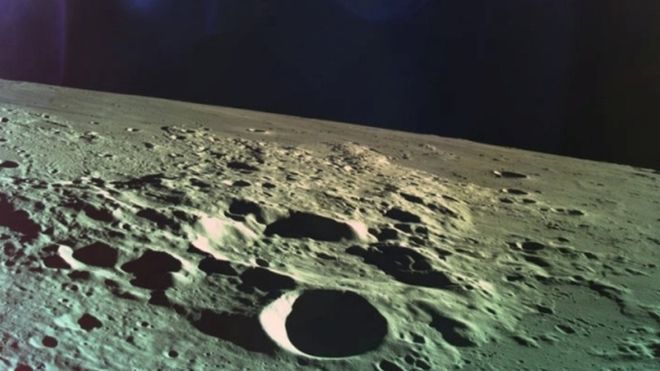Israel's Beresheet spacecraft crashes on Moon

The first privately funded mission to the Moon has crashed on the lunar surface after the apparent failure of its main engine.
The Israeli spacecraft - called Beresheet - attempted a soft landing, but suffered technical problems on its descent to the Moon's surface.
The aim of the mission was to take pictures and conduct experiments.
Israel hoped to become the fourth country to land a spacecraft on the Moon.
Only government space agencies from the former Soviet Union, the US and China have made successful Moon landings.
"We didn't make it, but we definitely tried," said project originator and major backer Morris Kahn.
"I think that the achievement of getting to where we got is really tremendous, I think we can be proud," he said.
Prime Minister Benjamin Netanyahu, watching from the control room near Tel Aviv, said: "If at first you don't succeed, you try again."
After a seven-week journey to the Moon, the unmanned spacecraft approached a final orbit at 15km (9m) from the surface.
Tensions were high in the command centre as communications were lost before Opher Doron, the general manager of Israel Aerospace Indurstries' space division, announced there had been a failure in the spacecraft.
"We unfortunately have not managed to land successfully," he said.
The audience outside had been through a turbulent journey themselves as they watched the first part of the landing go to plan.
As Mr Doron announced that the engine had cut out, groans filled the room.
"We are resetting the spacecraft to try to enable the engine," he said.
Image copyrightSPACEILImage captionThe spacecraft enlarged its path around Earth until it was captured by the Moon's gravity
How hard was it to land?
A controlled landing on the lunar surface was the major challenge for the Israeli spacecraft.
The engine was British-built, developed by Nammo in Westcott, Buckinghamshire. It provided the power to get the spacecraft all the way to the Moon, but it also took Beresheet on its final descent.
The 1.5m-tall spacecraft had to rapidly reduce its speed, so a final firing of the engine in effect slammed on the brakes, hoping to take the spacecraft to a gentle stop.
Before the landing, Rob Westcott, senior propulsion engineer at Nammo, said "We've never used an engine in this kind of application before".
He said the big challenge would be "the fact that the engine is going to have to be switched on and get very hot, then switched off for a short period of time when all that heat is remaining in its thermal mass, and then fired up again, very accurately and very precisely such that it slows the craft down and lands very softly on the surface on the Moon."
That landing process took around 20 minutes. All of the controls for this were uploaded and performed autonomously with mission control watching on.
What was the spacecraft supposed to do on the Moon?
Its first job was to use its high resolution cameras to take some photos - including a selfie - which it did manage before the crash.
It was then going to measure the magnetic field of the spot it landed in, an area known as Mare Serenitatis.
Image copyrightSPACEILImage captionPictures of the moon plus a selfie taken by Beresheet as it made its descent
Monica Grady, professor of planetary and space science at Open University, said it would be "looking at the landing site really closely". This would help "work out how the magnetic measurements of the Moon fit in with the geology and geography of the Moon, which is really important to understand how the Moon formed".
The lander also carried a reflector from Nasa to help scientists make accurate measurements of the distance between the Earth and the Moon.
Temperatures on the Moon are extreme, and as the Sun rose the spacecraft would have been unlikely to survive the heat.
Image copyrightBERESHEETImage captionThe spacecraft will study the Moon's magnetism while on the lunar surface
How significant was this mission?
Over 60 years of space exploration, only three nations have made it down onto the Moon.
The former Soviet Union achieved the first soft landing with its spacecraft Luna 9 in 1966. Nasa followed this by getting the first humans to the Moon in 1969. Then, China's Change-4 spacecraft touched down on the far-side of the Moon earlier this year.
Israel would have been the fourth nation to join this elite club.
But it was the low-price tag - and the fact that the mission was not funded by a major space agency - that was significant.
Image copyrightGETTY IMAGESImage captionA photo taken by the spacecraft of the earth from a distance of 37,600 km (23400m)
Beresheet was not alone in pursuing low-cost lunar exploration.
Its origins lie in the Google Lunar XPrize, an international challenge offering $20m for the first privately developed spacecraft to land on the Moon.
And while the competition ended last year after no-one was able to meet its deadline (the foundation has subsequently announced they will award the Beresheet collaboration $1m for their achievement), other teams involved are also continuing with their efforts to get to the Moon.
Both Nasa and Esa have also announced their intention to use commercial landers to deliver scientific payloads to the lunar surface.
Follow Rebecca on Twitter.
Related Topics
Share this story About sharing
Related Internet links
The BBC is not responsible for the content of external Internet sites
More Videos from the BBC
Elsewhere on BBC
You Might Also Like
From Around the Web
Top Stories
Wikileaks co-founder Julian Assange arrested He faces extradition to the US for his alleged role in one of the largest leaks of government secrets.
Who is Julian Assange?8 hours ago
India's marathon election kicks off9 hours ago
Features




